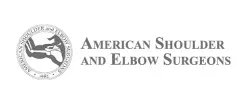I had the privilege of being invited by Dr. Joseph Zuckerman to author a chapter in an upcoming textbook about the Ream and Run Operation. This is a type of shoulder replacement, pioneered by Frederick A. Matsen, III, MD, a master shoulder arthroplasty surgeon and thought leader on the management of glenohumeral arthritis. Matsen recognized that younger patients with shoulder arthritis and those who remain very physically active are at risk for loosening and failure of the glenoid (socket) implant after a total shoulder replacement. He also recognized that replacement of the humeral head alone could not address changes to the shape of the socket that occur from arthritis. This primarily involves wear of the posterior portion of the socket with consequent decentering of the humeral head. Eventually this process produces a second concavity and thus this condition is known as the bi-concave glenoid.
Failure to address biconcavity results in poor results after partial shoulder replacement. The Ream and Run represents a hybrid of ideas between partial and total shoulder replacement. While the glenoid is not replaced, the socket is prepared in a manner that allows the humeral head replacement to recenter itself allowing for distributed load transfer.
The principles of the Ream and Run, as put forth by Matsen are as follows, and these are essential to a successful result. Failure to achieve these goals can result in residual glenoid erosion and pain that may necessitate revision surgery.
1. The glenoid must be reshaped into a single concavity with a curvature that closely matches that of the replaced humeral head.
2. The head must be recentered into this concavity using a combination of techniques such as contracture releases, humeral head position and orientation and capsular tensioning.
3. Bone must be preserved at all costs to avoid glenoid bone loss that can occur through corrective reaming. Excessive posterior glenoid version, caused by arthritic wear, does not need to be corrected through reaming as long as Principles 1 & 2 are met.
4. Restoration of range of motion is critical to prevent postoperative stiffness which has been associated with subsequent glenoid erosion and pain.
Matsen has shown that with a consistent technique that achieves these goals, outcomes comparable to total shoulder replacement can be achieved without the worry of glenoid implant failure.1–3 This figure demonstrates postoperative xrays after a Ream and Run showing a congruent, single glenoid concavity and a centered humeral head.
While a properly performed surgery is important to prevent failures attributable to improper technique or implant selection, more than half of the success comes from the postoperative rehabilitation. Recovery from this surgery can progress for more than a year and achieving an excellent outcome is highly contingent on a firm commitment by the patient. Charles Neer, II, MD, a pioneer of shoulder replacement, noted, “Because of the important of the exercise program following shoulder arthroplasty, it is essential that the patient understands his or her role and wants to cooperate. Patients should know that the arthroplasty simply sets the stage for them to do the exercises required to achieve the pain relief, motion and function desired.”4
Learn more about our shoulder surgery options, here.
1. Somerson JS, Neradilek MB, Service BC, Hsu JE, Russ SM, Matsen FA. Clinical and Radiographic Outcomes of the Ream-and-Run Procedure for Primary Glenohumeral Arthritis. J Bone Joint Surg Am. 2017;99(15):1291-1304. doi:10.2106/JBJS.16.01201
2. Lynch JR, Franta AK, Montgomery WH, Lenters TR, Mounce D, Matsen FA. Self-assessed outcome at two to four years after shoulder hemiarthroplasty with concentric glenoid reaming. J Bone Joint Surg Am. 2007;89(6):1284-1292. doi:10.2106/JBJS.E.00942
3. Matsen FA, Warme WJ, Jackins SE. Can the ream and run procedure improve glenohumeral relationships and function for shoulders with the arthritic triad? Clin Orthop. 2015;473(6):2088-2096. doi:10.1007/s11999-014-4095-7
4. Charles S. Neer, II. Shoulder Reconstruction. W.B. Saunders Company; 1990.














